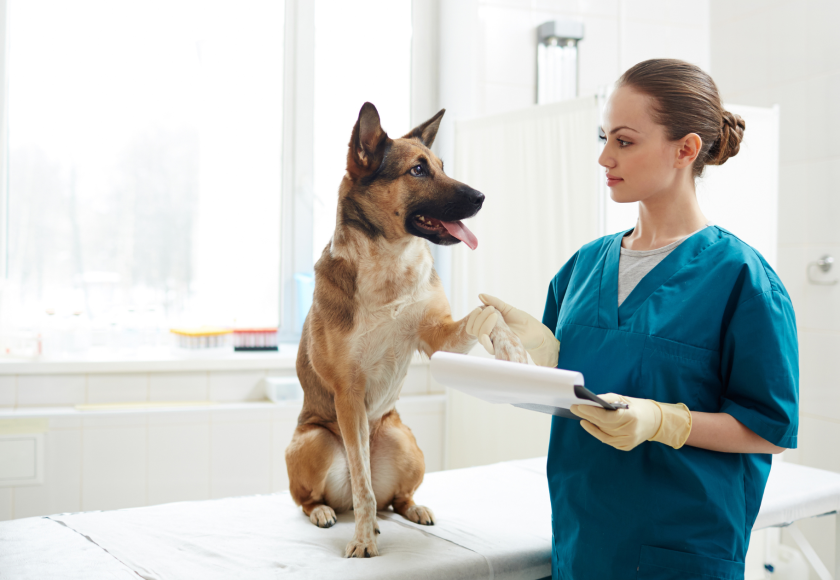Dog ear diseases are common problems faced by many pet owners. These diseases can be not only unpleasant but also painful for your pet. Timely detection of symptoms and consultation with a veterinarian can ensure proper treatment and help avoid more serious consequences.
Table of contents
Signs of ear diseases in dogs. How to recognize ear diseases in dogs?
- Itchy ears and rubbing of the ears against objects in the environment: the dog constantly rubs its paws or the head of an object in the environment, scratches one or both ears, shakes its head, trying to reduce the itching and discomfort in its ears.
- Red or swollen ears: the ears may become swollen, red, or may start to bleed due to intense scratching.
- Bad smell from the ear and profuse, dark ear discharge: in case of infection, the ears may emit an unpleasant odor and also secrete a yellowish, brown or even bloody discharge.
- Pain: due to ear pain, the dog may show signs of pain, such as pulling away when the ears or the area around them are touched, showing anger when the ears are touched, wanting to be left alone, apathy, lethargy, loss of appetite.
- Head shaking: why does a dog shake its head? Due to itching or discomfort in the scalp and ears. Dogs that shake their heads frequently may be experiencing various dogs’ allergies, fleas, or other skin and ear problems that cause itching. This discomfort prompts the dog to try to relieve the itching in various ways, including shaking its head. Dogs also often shake their heads due to ear infections.
It is important to pay attention to any other changes in your dog’s behavior along with head shaking. If you notice other symptoms or if the head shaking becomes constant or intense, it is necessary to consult a veterinarian. The veterinarian can perform a thorough examination, identify possible health problems, and prescribe treatment.
It is also important to note that head shaking in dogs can be completely harmless behavior. Some dogs simply enjoy shaking their heads while playing, and long-haired dogs often shake their heads to try to get hair out of their eyes. However, if you notice that this behavior is new or accompanied by other symptoms, it is best to be cautious and consult with your veterinarian.
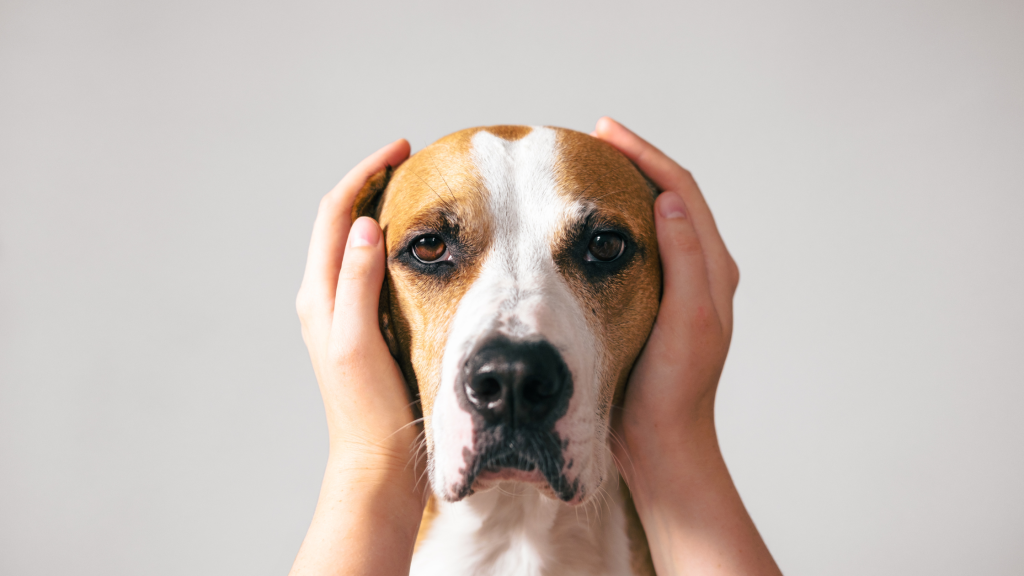
Dog ear diseases
Dog ear diseases can be caused by various factors and are classified into different types accordingly. Some of the most common dog ear diseases are:
Otitis (ear infection in dogs)
This is one of the most common ear diseases in dogs. Otitis is an inflammation of the dog’s ear, which can be bacterial or fungal. It can be primary, caused by various bacteria or fungi, or secondary, caused by ear mites, allergies, water entering the ear, foreign bodies, or congenital disorders.
Otodectomy (ear mites in dogs)
These are mites that live in the ears and can cause irritation and inflammation. Dog ear mites are parasitic organisms that live in dogs’ ears and can cause itching and discomfort. Treatment for ear mites in dogs may involve the use of special medications designed to kill the parasites, along with cleaning the ears.
Once your veterinarian has diagnosed ear mites in your dog, they may recommend special ear drops or a solution to help eliminate the ear mites and relieve your dog’s symptoms. It is important to check your dog’s ears regularly and consult a veterinarian promptly if you notice any symptoms associated with ear mites in dogs.
If you notice abundant dark brown discharge in your dog’s ears, do not delay and contact a veterinary clinic for help, as ear mites in dogs need to be treated as soon as possible to avoid complications.
Otomycosis (ear fungus in dogs)
This is a fungal infection that can develop if dirty water frequently enters the ears, or if the inside of the ears is often moist and oily due to other diseases. Only veterinarians can diagnose and treat ear fungus in dogs, so it is important to seek medical attention in a timely manner.
Otohematoma (bruise on a dog’s ear)
This is bleeding under the skin inside the ear. It can be caused by ear trauma or infection. As fluid accumulates under the skin, local inflammation occurs, and the ear becomes hot and swollen. If left untreated, the ear may change shape, wrinkle, harden, and cause significant discomfort. The ear is especially painful to the touch, so it is best to visit a veterinarian and begin treatment immediately.
Polyps in the ears
These are benign growths that can develop in the ears due to various genetic or environmental factors. Polyps in the ear can impair hearing and cause discomfort.
Blocked ear
Sometimes dogs can have a blocked ear due to a blockage in the ear canal caused by earwax, ear infection, or a foreign object in the ear canal. This ear condition causes the dog to constantly scratch its ear, shake its head, and experience hearing loss.
It is important to notice any symptoms such as itching of the ear, shaking of the dog’s head, redness, bad smell or discoloration of the ear, excessive discharge, and consult a veterinarian-dermatologist for a proper diagnosis and treatment. A veterinary dermatologist will be able to identify the specific problem and prescribe the most appropriate treatment.
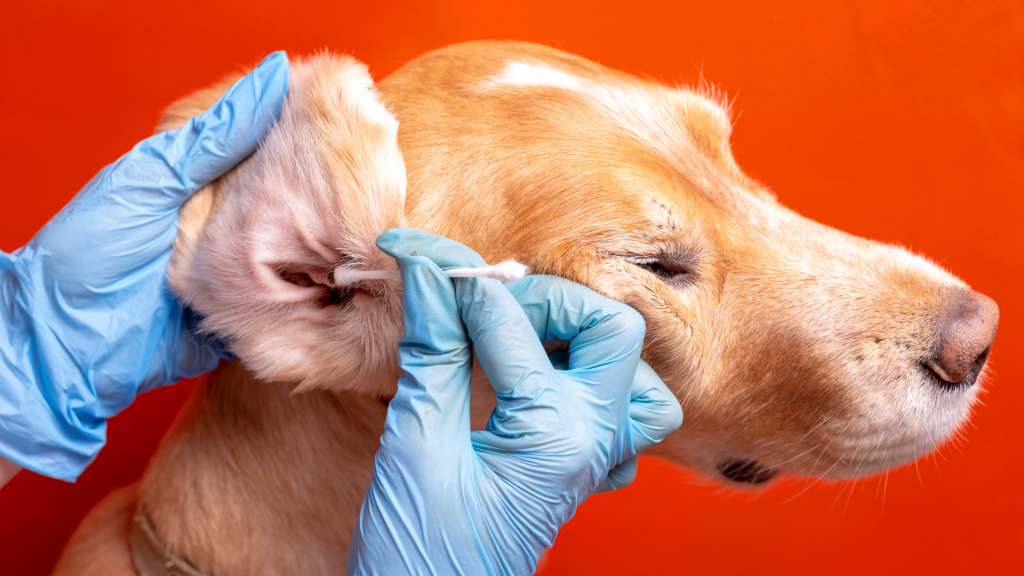
Treatment of ear diseases in dogs
Treatment depends on the cause of the dog’s ear disease. Only after conducting the necessary and thorough examinations can a veterinarian prescribe the most appropriate treatment plan. To determine the causes of ear disease in dogs, it may be necessary to perform not only a thorough examination of the ears, but also microscopic examinations and tests for bacterial or fungal cultures and drug resistance.
Medications: Generally speaking, when it comes to the medical treatment of ear diseases, a veterinarian who has determined the cause of the disease may prescribe antibiotics, anti-inflammatory, or antifungal medications.
Surgical treatment of ear diseases in dogs
In some cases, such as severe infections, polyps, foreign bodies in the ear canal, or tumors, surgical treatment may be necessary.
Treatment of ear mites in dogs
If a microcopy examination reveals ear mites in dogs, treatment is prescribed by a veterinarian, with proper ear cleaning and prescription medications being the most important aspects.
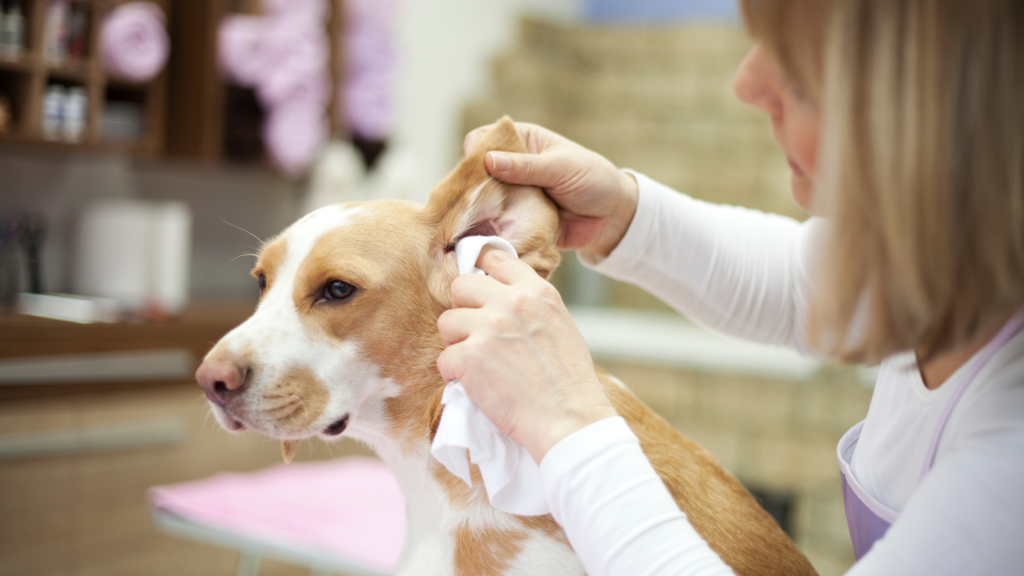
Medicines for dogs for ear infections
Medications for ear infections in dogs vary depending on the cause and severity of the infection. The most commonly used medications include antibiotic ear drops, which help control bacterial infections and reduce symptoms.
In addition, anti-inflammatory medications such as corticosteroids may be used to reduce pain and swelling in the ears. Antifungal medications may also be prescribed if the inflammation is caused by a fungal infection.
It is important to follow your veterinarian’s instructions and administer the medication correctly to achieve the best treatment results. Consult your veterinarian for more detailed information and advice on choosing the right medication for your dog.
Cleaning dogs’ ears
Sometimes it is necessary to clean the ear of accumulated sulfur, wax secretions, or other substances to facilitate treatment. Cleaning your dog’s ears is an important part of dog care, especially if your dog is prone to ear problems. Every owner can clean their dog’s ears properly – Begemotas veterinary specialists remind you how to do it correctly.
Dog ear cleaning supplies you will need
- Ear cleaning solution: You can purchase a special ear cleaning solution at a veterinary clinic or pharmacy.
- Cotton swabs: It is essential to choose soft cotton swabs and ear cleaning sticks to avoid damaging the ear.
The process of cleaning dogs’ ears
1. Preparation: Ensure that you and your dog are calm. Make the process as pleasant as possible for your dog by being gentle and encouraging, and by giving your pet a treat before and after cleaning its ears.
2. Pouring the solution into the ear: Hold your dog’s head so that the ears are easily accessible. Pour a small amount of solution into the ear, but not too deep—just enough to reach the dirt.
3. Massage: Gentle massage movements will help the solution reach the inside of the ear. Massage the base of the ear (under the ear) to distribute the solution evenly.
4. Removal of dirt: After a few minutes of pouring the ear cleaning solution and massaging it into the ear canal, you can use a cotton swab or ear cleaning sticks to remove discharge and dirt from the outer surface of the ear. Don’t worry, dogs’ ears are anatomically L-shaped, so it is really difficult to damage the eardrum.
5. After cleaning: Reward your dog with a tasty treat or play together so that your pet associates ear cleaning with positive emotions.
Repeat if necessary: if the ears are still dirty, you can repeat these steps.
How often should you clean your dog’s ears?
How often you need to clean your dog’s ears depends on each dog’s individual needs and susceptibility to ear diseases. Most veterinarians recommend cleaning ears at least once a month, but this may vary depending on the dog’s breed, living conditions, and other factors.
If you notice any signs of ear problems or are unsure how to clean your dog’s ears properly, it is best to consult your veterinarian for advice and assistance.
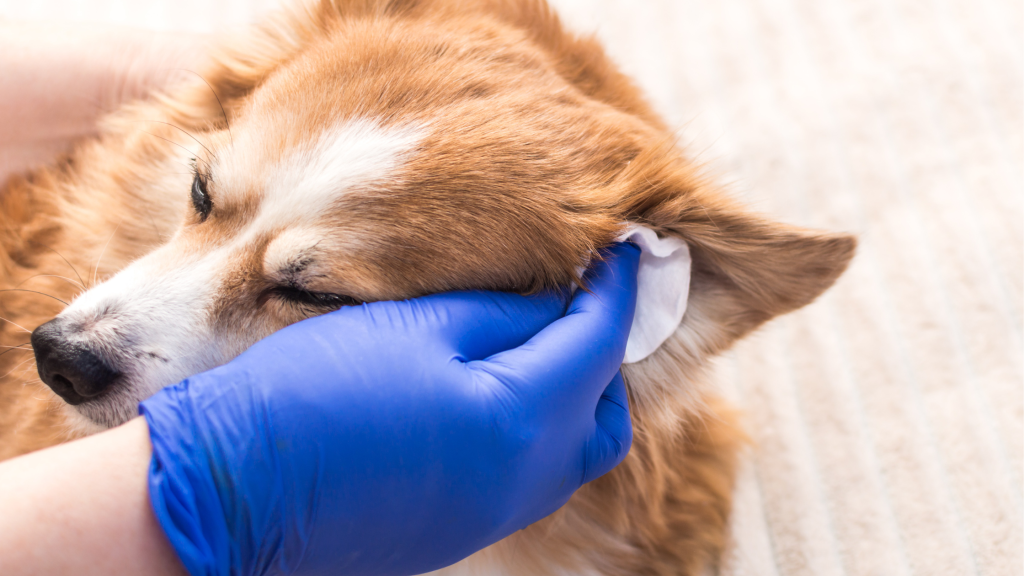
When should you consult a veterinarian about ear diseases in dogs?
- Shaking the head: Shaking the head may be associated with ear diseases, infections, anatomical problems, and hearing problems in dogs.
- Constant itching of the ear: Long-term itching of the ear may indicate a bacterial or fungal infection.
- Discharge or bad smell: if you notice any discharge from the ear or smell something unpleasant, this may indicate an infection.
- Ear injury: if your dog has suffered an injury to the ear, even if it does not appear to be serious, it is best to consult a vet. Ear injuries are usually on the inside of the ear, not on the outside.
- Recurring ear problems: if your dog regularly has ear problems, this may indicate a chronic ear disease that should be evaluated by a veterinary dermatologist.
- Extreme discomfort: if your dog shows signs of severe pain, gets angry when you touch its ears, refuses to eat or drink, or becomes apathetic or lethargic, consult a veterinarian immediately.
Dog ear diseases can be unpleasant for both the dog and its owner, but timely detection of symptoms and proper treatment can ensure a quick recovery and prevent complications.
If you notice any signs of ear problems in your dog, do not hesitate to contact the Begemotas veterinary clinic in Vilnius, where veterinarian-dermatologist Milda will make an accurate diagnosis and begin treatment without delay.
The slogan of the Begemotas veterinary clinic, “Healthy because happy” is the philosophy of life of veterinary doctors and a guarantee of your pet’s health. It is always important to monitor your pet’s behavior and respond to any changes or unusual symptoms. Timely attention can help prevent or diagnose potential health problems in your dog early on.





